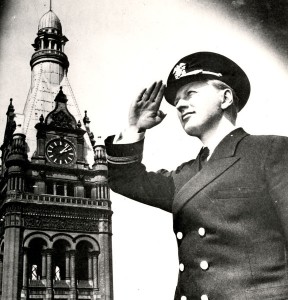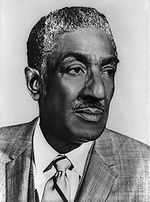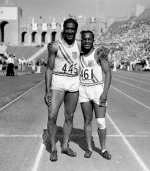Francis Swietlik, Marquette Law School, and Polish War Relief
Francis X. Sweitlik, Dean of the Marquette College of Law from 1934 to 1953, was a nationally recognized leader of the American Polish community from the early 1930’s until the 1960’s. During World War II, he was a leading figure in the effort to provide relief for Polish refugees and prisoners of war, and his efforts extended to the provision of general humanitarian aid to the country once the war was over. Although he initially cooperated with Poland’s post-war Communist government, once it became clear that Poland had become a satellite state of the Soviet Union, he joined the ranks of those who campaigned for the restoration of a non-Communist, democratic government in that country.
Swietlik was born in Milwaukee in 1889 to parents who had recently emigrated from Poland. He was educated at Marquette where he earned his bachelors, masters, and law degrees. He began the practice of law in Milwaukee in 1915, and in 1916, he joined the Marquette law faculty on a part-time basis. He taught at the Law School while practicing law for the next seventeen years (save for the time he was in the military during World War I), and he was named Dean in the fall of 1933 when the previous Dean, Clifton Williams, resigned.
In addition to his career as a lawyer and legal educator, Swietlik was a leading member of the Polish-American community in the United States. In 1931, he was elected Censor of the Polish National Alliance, the largest Polish fraternal group in the United States. The Censor was one of the organization’s two highest offices — the President was the other — and was very much a policy-making position. Swietlik held the position of Censor of the Polish National Alliance for sixteen years, but at the same time held a number of other important positions in the Polish-American community. In 1934, he was selected as Vice-President of the Polish-American Chamber of Commerce, and that same year he also presided over the American delegation to the International Congress of Poles Abroad, held in Warsaw. In 1939, he was also chosen as President of the Polish American Council, an organization founded to promote the preservation of Polish culture in the United States.
As a leader of the Polish-American community and the man who was generally recognized as the primary spokesmen for the Chicago Poles (which featured the largest concentration of Polish-Americans of any region of the United States), Swietlik opposed those who insisted that Poles living abroad remained citizens of Poland, which reappeared as an independent country in 1918, after having disappeared from the map of Europe more than a century earlier.
Such Polish nationals believed that expatriate Poles were first and foremost Polish citizen, regardless of where they lived, and as such they owed a duty of loyalty to the current Polish government. For Swietlik, in contrast, American Poles were Americans first and Poles second, and while he was proud of his Polish heritage (and was fully fluent in Polish), he believed that Poles in the United States owed no special obligations to the relatively new government in Warsaw.
After the German and Soviet invasions of Poland in September 1939, Swietlik became actively involved in the cause of Polish war relief, first as a leader of the Polish National Alliance and then as the director of the Polish National Council which eventually changed its emphasis and name to Polish War Relief. By one estimate, Swietlik raised almost $17 million dollars in the United States for humanitarian aid to Poles in Europe.
Swietlik was also a prominent defender of the foreign policy of President Franklin Roosevelt. As a supporter of the President, Swietlik advocated American support for the Polish government in exile in London, but he also endorsed the idea of Polish-Soviet cooperation in the war with Germany. Not all Polish-Americans agreed with Swietlik on the latter question. Although the government in exile also embraced the idea of cooperation with the Soviet Union, a growing number of American Poles found it troubling that the United States was not only allied with a country that had invaded Poland (the U.S.S.R.) but was also unwilling to pressure it to agree to reestablish the pre-1939 border between the two countries.
As the scope of atrocities committed against Poland by the Soviet Union became known in 1944 and 1945, and as it became clear that the U.S.S.R. was not going to return to Poland any of the territory that it had seized in 1939, many American Poles broke with the President. Swietlik, however, remained loyal to Roosevelt. He supported FDR’s decision to run for an unprecedented third term in 1940, and he campaigned extensively for him inside the Polish community. Swietlik also consulted personally with the President on Polish issues both before and after the 1940 election (which was, of course, won by Roosevelt).
By 1943, it was becoming apparent that Swietlik’s loyalty to Roosevelt and his polices were hurting his popularity among his fellow Polish-Americans, many of whom were increasingly hostile to what they viewed as FDR’s pro-Soviet Polish policy. When the Polish American Congress was formed in the fall of 1944 with an agenda that was clearly hostile to the Soviet Union, Swietlik was conspicuously ignored by its founders even though he had been one of the best known Polish-Americans in the country for the past several years (and even though he was present at the organizational meeting).
Although his political influence waned after 1944, Swietlik remained committed to raising money for relief of Poland. He travelled to Europe after V-E Day to survey the situation, and from 1945 to 1949 (when the Communist government of Poland announced that it would not accept any more humanitarian aid from the West) American Relief for Poland under his direction raised at least $3 million in aid. Remarkably, he accomplished all of this without ever taking a leave of absence from his duties at the Law School, which usually involved teaching a full load of courses.
In the aftermath of the war he received numerous citations for his efforts on behalf of the Polish population. He was honored by the governments of Poland, France, and Portugal (where American Relief for Poland had staged his rescue efforts after 1941), and in 1952, he was named a Knight of the Roman Catholic Order of St. Gregory by Pope Pius XII. He was also involved with the resettlement of 120,000 postwar Polish refugees into the United States, which had been made possible by an act of Congress in 1948. Although the organization was largely inactive after 1949, Swietlik remained president of American Relief for Poland into the late 1960’s.
In the postwar era, he also adopted a much more critical position on the Soviet Union and eventually denounced the policies of the Roosevelt administration that he had earlier supported. He remained Dean at Marquette Law School until 1953 when he was elected to the Circuit Court of Milwaukee County. He continued to teach at the Law School, even after his retirement from the bench at age 70 in 1959. He died in Milwaukee in 1983.



